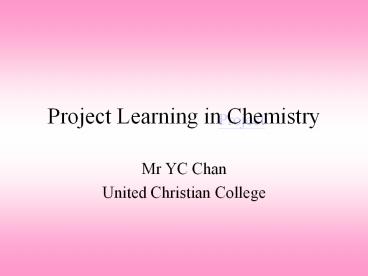Project Learning in Chemistry - PowerPoint PPT Presentation
Title:
Project Learning in Chemistry
Description:
Project Learning in Chemistry Project Mr YC Chan United Christian College Assessment of Project learning For TAS project work, teacher assessment can include: Plan ... – PowerPoint PPT presentation
Number of Views:148
Avg rating:3.0/5.0
Title: Project Learning in Chemistry
1
Project Learning in Chemistry
Project
- Mr YC Chan
- United Christian College
2
Project learning in TAS
- Purpose
- Project schedule
- Grouping
- Topics
- Working schedule
- Project proposal/Teachers approval
Project
3
Assessment of Project learning
- Students can be assessed once for ability area A
and once for area B. - A report may be submitted for the whole group of
students. - Area B for individual students is assessed by
their presentation.
4
Assessment of Project learning
- For TAS project work, teacher assessment can
include - Plan
- Progress
- Product
- Presentation
Area A
Area B
5
CHEMISTRY PROJECT PRESENTATION
6
Our objective is to extract the essential oil
(limonene) from orange peels and analyze it by
polarimetry.
Oh! Our topic is Isolation of (R)-()-Limonene
from orange peels.
7
Theory
8
R and S system
9
Direction Of Rotation (/-)
10
(No Transcript)
11
Polarimeter
12
A Real Polarimeter
13
1.Concentration
?The greater the concentration of molecules in
the path of the beam, the greater the
rotation.
2.Length of sample tube
?The rotation of the beam is proportional to the
length of the path.
3.Wavelength of light
?Generally, the magnitude of rotation is larger
at shorter wavelengths.
4.Solvent Temperature
14
Procedures
1. The white pulp was removed from the peels of
two oranges.
2. The peels were ground in a blender to make a
slurry. Then the slurry was poured into a
500 ml round-bottomed flask. 4 drops of an
antifoaming agent was added to the flask.
3. The 35 ml water level was marked on the
outside of the round-bottomed flask.
15
4. The steam distillation apparatus were set up
without the separatory funnel. The 50 ml
round-bottomed flask was used as receiver.
5. The orange peel mixture was boiled at a
moderately rapid rate by a heater. The 35 ml
distillate was collected.
16
6. The distillate was poured into a 125-ml
separatory funnel and 2 g of sodium chloride
was added in it.
7. The separatory funnel was stoppered, shaken
and vented for four or five times.
8. 15 ml chloroform was used to rinse the
apparatus and let the chloroform drain into
the separatory funnel.
17
9. The limonene was extracted from the aqueous
layer by inverting the separatory funnel and
shaking it back and forth gently.
10. The layers were allowed to separate before
draining the bottom organic layer into a
dry 50 ml Erlenmeyer flask.
18
11. The extraction of aqueous layer was repeated
by using another 10 ml of chloroform. Two
chloroform extracts were combined and dried
with anhydrous calcium sulfate for at least
10 min.
12. A dry watch glass was weighted. The
chloroform was filtered through filter paper
into the watch glass.
19
13. The chloroform was evaporated in a steam
bath.
14. The watch glass was cooled and was wiped the
outside dry before weighting it .
15. The watch glass was heated several
additional minutes, and then it was
weighted again. The final mass of limonene was
obtained.
16. 5 ml of 95 ethanol was obtained to dissolve
the obtained limonene.
20
17. After filtration,the limonene and 5-mL
ethanol was poured directly into the
polarimeter tube.
21
Results Calculation
22
limonene
23
(No Transcript)
24
After our discussion, we also think that
chloroform could be added to the orange slurry
before the process of steam distillation.So more
limonene can be extracted.But,at the same
time,many unknown substances will formed besides
limonene.
25
(No Transcript)
26
? The calculated specific rotation is
affected.
27
Questions
(1)Why do we need to add 2g of sodium chloride
into the distillate?
Ans The sodium chloride helps to minimize
emulsions during the extractions by
making the organic layer less soluble in
the aqueous layer.
(2)Why do we dissolve the limonene in the ethanol
at the end of the experiment?
Ans It is because ethanol have no optical
activity. It does not have specific
rotation.
28
(3)Why we must peel the oranges just before
grinding the peels?
Ans In order to prevent loss of the volatile
limonene.
29
(No Transcript)































